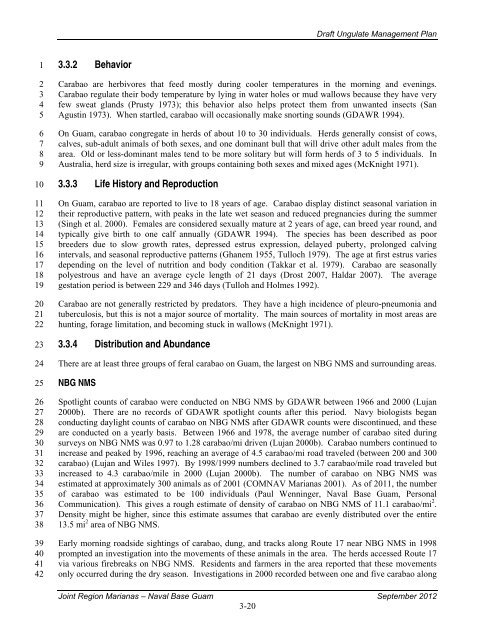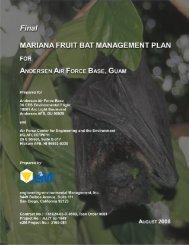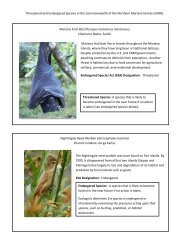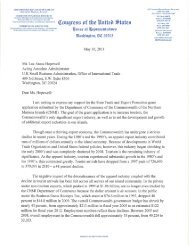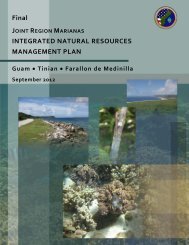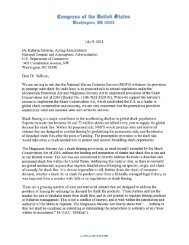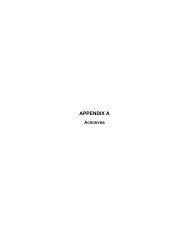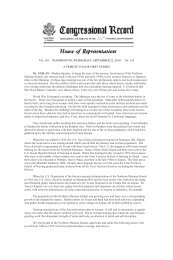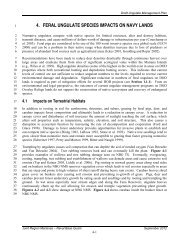Public Review JRM INRMP Appendices 092412-4
Public Review JRM INRMP Appendices 092412-4
Public Review JRM INRMP Appendices 092412-4
You also want an ePaper? Increase the reach of your titles
YUMPU automatically turns print PDFs into web optimized ePapers that Google loves.
Draft Ungulate Management Plan1234567891011121314151617181920212223242526272829303132333435363738394041423.3.2 BehaviorCarabao are herbivores that feed mostly during cooler temperatures in the morning and evenings.Carabao regulate their body temperature by lying in water holes or mud wallows because they have veryfew sweat glands (Prusty 1973); this behavior also helps protect them from unwanted insects (SanAgustin 1973). When startled, carabao will occasionally make snorting sounds (GDAWR 1994).On Guam, carabao congregate in herds of about 10 to 30 individuals. Herds generally consist of cows,calves, sub-adult animals of both sexes, and one dominant bull that will drive other adult males from thearea. Old or less-dominant males tend to be more solitary but will form herds of 3 to 5 individuals. InAustralia, herd size is irregular, with groups containing both sexes and mixed ages (McKnight 1971).3.3.3 Life History and ReproductionOn Guam, carabao are reported to live to 18 years of age. Carabao display distinct seasonal variation intheir reproductive pattern, with peaks in the late wet season and reduced pregnancies during the summer(Singh et al. 2000). Females are considered sexually mature at 2 years of age, can breed year round, andtypically give birth to one calf annually (GDAWR 1994). The species has been described as poorbreeders due to slow growth rates, depressed estrus expression, delayed puberty, prolonged calvingintervals, and seasonal reproductive patterns (Ghanem 1955, Tulloch 1979). The age at first estrus variesdepending on the level of nutrition and body condition (Takkar et al. 1979). Carabao are seasonallypolyestrous and have an average cycle length of 21 days (Drost 2007, Haldar 2007). The averagegestation period is between 229 and 346 days (Tulloh and Holmes 1992).Carabao are not generally restricted by predators. They have a high incidence of pleuro-pneumonia andtuberculosis, but this is not a major source of mortality. The main sources of mortality in most areas arehunting, forage limitation, and becoming stuck in wallows (McKnight 1971).3.3.4 Distribution and AbundanceThere are at least three groups of feral carabao on Guam, the largest on NBG NMS and surrounding areas.NBG NMSSpotlight counts of carabao were conducted on NBG NMS by GDAWR between 1966 and 2000 (Lujan2000b). There are no records of GDAWR spotlight counts after this period. Navy biologists beganconducting daylight counts of carabao on NBG NMS after GDAWR counts were discontinued, and theseare conducted on a yearly basis. Between 1966 and 1978, the average number of carabao sited duringsurveys on NBG NMS was 0.97 to 1.28 carabao/mi driven (Lujan 2000b). Carabao numbers continued toincrease and peaked by 1996, reaching an average of 4.5 carabao/mi road traveled (between 200 and 300carabao) (Lujan and Wiles 1997). By 1998/1999 numbers declined to 3.7 carabao/mile road traveled butincreased to 4.3 carabao/mile in 2000 (Lujan 2000b). The number of carabao on NBG NMS wasestimated at approximately 300 animals as of 2001 (COMNAV Marianas 2001). As of 2011, the numberof carabao was estimated to be 100 individuals (Paul Wenninger, Naval Base Guam, PersonalCommunication). This gives a rough estimate of density of carabao on NBG NMS of 11.1 carabao/mi 2 .Density might be higher, since this estimate assumes that carabao are evenly distributed over the entire13.5 mi 2 area of NBG NMS.Early morning roadside sightings of carabao, dung, and tracks along Route 17 near NBG NMS in 1998prompted an investigation into the movements of these animals in the area. The herds accessed Route 17via various firebreaks on NBG NMS. Residents and farmers in the area reported that these movementsonly occurred during the dry season. Investigations in 2000 recorded between one and five carabao alongJoint Region Marianas – Naval Base Guam September 20123-20


